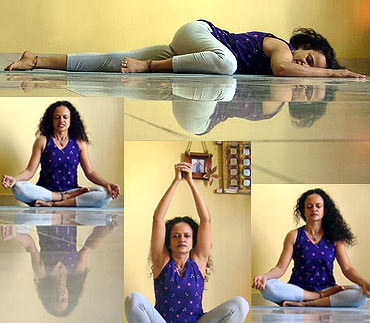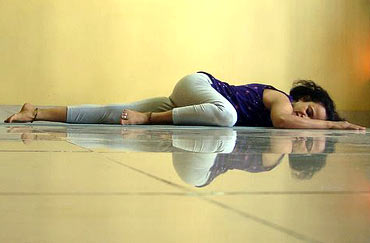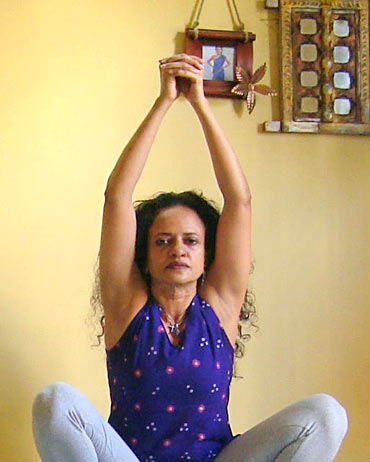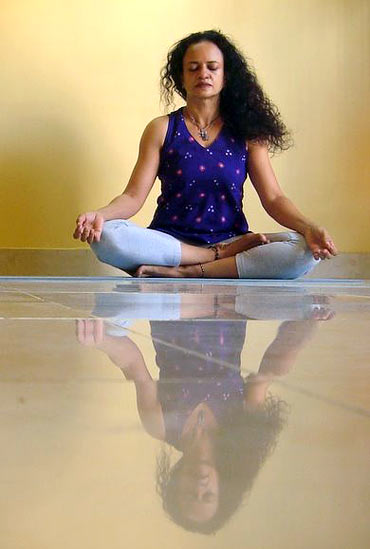 | « Back to article | Print this article |
Yogic postures for pregnant women
In the second of a two-part feature on yoga during pregnancy, yoga acharya Shameem Akthar outlines a few more poses to benefit to-be mothers.
During pregnancy, remaining active as usual (unless otherwise advised) helps maintain physical health and mental outlook. Enrolling in a prenatal yoga class with a modified, personalised practice will further help not just with the entire pregnancy, but also in dealing with post-natal depression and demands with a greater sense of awareness and control. It will also help a woman get back in shape faster and more easily.
It is believed that a growing embryo is affected by not just what the mother is feeding upon, but also her feelings. Research has proved that her breathing pattern -- deep and gentle breathing which indicates she feels calm and in-control or rapid, short breaths which signal distress; her heart beat rate which can indicate calmness when it is steady or signal anxiety if erratic and rapid; and the hormonal flow of adrenaline and other neuro-chemicals can create an equivalent cocktail of reactions in the embryo -- affecting the growing child long-term, right into adulthood.
There are many dos and don'ts for yoga during pregnancy (See our earlier column on the same topic). A few more yoga practices that help mothers-to-be are outlined in the following pages.
Disclaimer: This column only seeks to share the author's enthusiasm towards yoga. Yoga is best learnt under expert guidance.
Shameem Akthar, yoga acharya trained with the Sivananda Yoga Vedanta Center, takes you through a few safe practices during pregnancy. However, remember to use this column only as a general guide; it is extremely important to practice a personalized programme with an expert pre-natal yoga teacher. Also, even classic poses, including the corpse or shavasana, has to be modified to accommodate the widening abdomen.
Catch more of Shameem's yoga writings or upcoming workshops from http://jaisivananda.blogspot.com
Visualisation
Lie in the flying fish pose (see earlier column) and focus on consciously relaxing the body completely, by taking your awareness to each part of the body and relaxing it deliberately.
Focus next on the breath, not forcing it to calm down, but becoming aware of it intensely so that it calms down on its own. Then count the breath backwards from fifty to one.
By this time, your mind will have settled into a relaxed, almost trance-like mode. At this point, you can visualise that your breath is reaching from above like streaks of gentle light, pervading your body and converging specially on the abdomen to reach into the womb, to improve and benefit the growing life there. Keeping this simple visualisation in mind, continue to focus on the breath, the womb and the sense of light and energy flowing into your body to reach right into your womb. After a few minutes, you can slowly draw your mind from this visualisation and move your limbs gently before sitting up to finish the practice.
This visualisation may also be attempted seated in a chair, if that is more comfortable. Several such simple visualisations may be created to calm yourself and reach your awareness to the growing life. If such visualisations are difficult for you, you can try meditation tapes for pregnant women.
Seetali (cooling breath)
Sit in any simple cross-legged position. Shut your eyes. Keep your hands in chin mudra (tips of index and thumb touching lightly). Roll your tongue back, to touch the palate. Keep the upper and lower set of teeth lightly touching, inhale from the mouth. Then exhale from the nostril. This is one round. Do up to nine rounds.
Benefits: Keeps you calm. Controls unwanted hunger. Controls anxiety and anger.
Avoid: Doing this in polluted places, since mouth-breathing is involved.
Kashtha Takshanasana (wood chopping pose)
Squat with feet flat on the ground, knees apart. If you are stiff, you may attempt this standing, with knees apart. Interlock hands. Inhale, raising arms overhead, looking at the hands. Exhaling deeply, drop the hands, lowering head. This is one round. Do five to ten rounds.
Benefits: Makes the pelvic region supple, readying it for delivery. Deepens breath. Strengthens back.
Avoid: If you have a history of complications, especially from the sixth month onwards. This pose can be extreme for those who have been physically inactive. Before attempting this pose you must consult your pre-natal expert if it is advisable for your particular case.
Sukhasana (easy pose)
Sit with legs out in front. Fold the left leg at the knee. Fold right leg at knee and place it over left leg. Sit for a few seconds or minutes, as per your comfort level, with eyes shut and mind focused on the breath.
Benefits: Cross-legged poses increase circulation to the torso and brain.
Avoid: If you suffer from knee pain.




